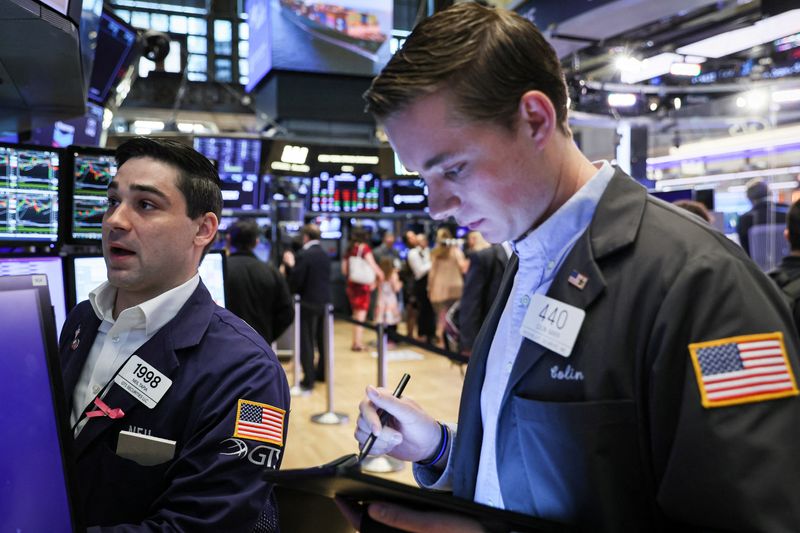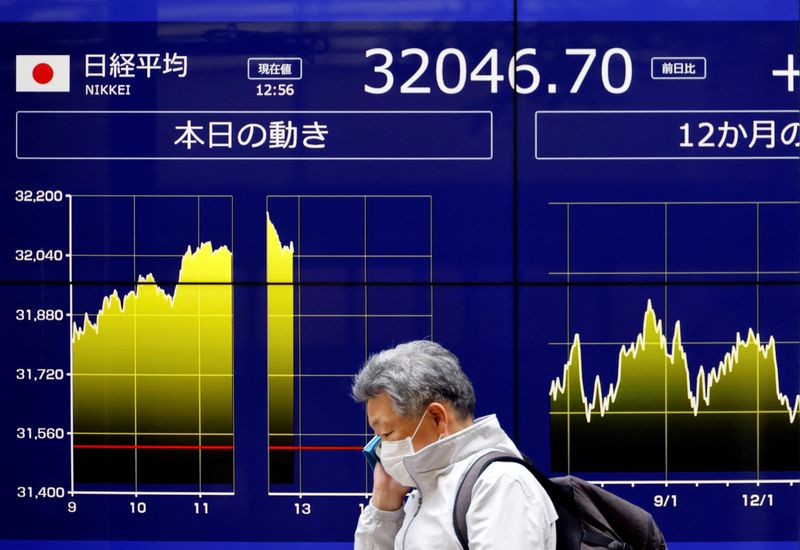By Herbert Lash
NEW YORK (Reuters) - Global shares rallied and the dollar eased on Tuesday after U.S. consumer price data showed inflation barely rose in May, increasing expectations the Federal Reserve will pause hiking interest rates when it concludes a two-day meeting on Wednesday.
The annual increase in the consumer price index was the smallest in more than two years. But underlying price pressures are still strong, suggesting inflation will not easily cool and will keep the door open to a future Fed hike.
Equities rallied, with the tech-heavy Nasdaq up almost 30% year-to-date. The surge has many in the market questioning a rally driven by just seven or eight mega-cap stocks that often is compared to the dot-com boom and bust two decades ago.
"At the time valuations of tech stocks had gotten ahead of themselves and they continued to run until they didn't," said Phil Orlando, chief equity strategist at Federated Hermes in New York.
"What is the catalyst, when is the market going to start to reverse this? I don't know. I would have thought it would have started by now. But it hasn't."
The S&P 500 and Nasdaq rose to fresh one-year highs, helping lift MSCI's U.S.-centric gauge of stocks across the globe up 0.84% on the day, and 11.8% for the year.
In Europe, the pan-regional STOXX 600 index closed up 0.55%, while on Wall Street the Dow Jones Industrial Average advanced 0.43%, the S&P 500 gained 0.69% and the Nasdaq Composite rose 0.83%.
Expectations the Fed will keep its target rate unchanged on Wednesday in a range of 5%-5.25% rose to 91.9%, but the likelihood of a rate hike at the Fed's policy meeting ending on July 26 rose to 60.1%, according to CME Group's (NASDAQ:CME) FedWatch Tool.
The strength of the economy will dictate whether the Fed hikes again later this year, said Joseph LaVorgna, chief U.S. economist at SMBC Nikko Securities in New York.
"I'm not sure it's going to be driven by inflation per se, because again, the core is going to stay sticky for a while," he said. "It's going to be because either broad GDP trends re-accelerate or the labor market doesn't show any signs of loosening."
{{2126|The dodollar index, which measures the U.S. currency against six peers, eased 0.28% as the rate differential fell ahead of a likely hike by the European Central Bank on Thursday and possibly the Bank of England next week. The Bank of Japan is expected to maintain its ultra-loose policy on Friday.
Both the euro and Sterling are likely to continue to do well against the dollar, but the more important factor is China, said Thierry Wizman, Macquarie's global FX and interest rates strategist.
"China is the key. If we start to see growth and stimulus out of China, the dollar will weaken again just like it was weakening in March and April when everyone was convinced China would see strong growth," he said.
The euro gained 0.32% to $1.0791, sterling rose 0.73% to $1.2609, and the yen weakened 0.42%.
The benchmark 10-year Treasury yield rose 5.6 basis points to 3.821%, reversing initial declines after data pointed to a slowing pace of inflation.
Meanwhile, data showing a rapid pickup in UK wage growth in the three months to April could complicate matters for the Bank of England, which is already grappling with inflation that is more than four times its target of 2%.
"The key takeaway here is, not only was unemployment not ticking higher, we've got strong jobs growth and also wage growth is just extremely high right now and that's going to be making the Bank of England feel very uncomfortable," City Index senior markets analyst Fiona Cincotta said.
Money markets show traders now anticipate UK rates peaking at around 5.7% by December, up from a terminal rate of 4.85% by November a month ago.
Oil prices climbed more than 3%, recovering from steep losses in the previous session, after China's central bank lowered a short-term lending rate for the first time in 10 months.
U.S. crude rose $2.30 to settle at $69.42 a barrel while Brent settled up $2.45 at $74.29 a barrel.

Gold slipped as Treasury yields rebounded, while traders firmed up bets the Fed would stand pat on interest rates.
U.S. gold futures settled 0.6% lower at $1,958.60 an ounce.
